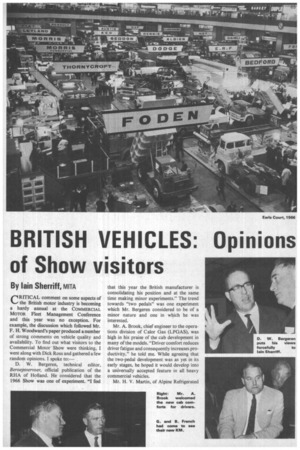BRITISH VEHICLES: Opinions of Show visitors
Page 67

Page 68

If you've noticed an error in this article please click here to report it so we can fix it.
By lain Sherriff, MITA CRMCAL comment on some aspects of the British motor industry is becoming a hardy annual at the COMMERCIAL MOTOR Fleet Management Conference and this year was no exception. For example, the discussion which followed Mr. F. H. Woodward's paper produced a number of strong comments on vehicle quality and availability. To find out what visitors to the Commercial Motor Show were thinking, I went along with Dick Ross and gathered a few random opinions. I spoke to:— .
D. W. Bergeren, technical editor, Beroepsvervoer, official publication of the RHA of Holland. He considered that the 1966 Show was one of experiment. "I feel
that this year the British manufacturer is consolidating his position and at the same time making minor experiments." The trend towards "two pedals" was one experiment which Mr. Bergeren considered to be of a minor nature and one in which he was interested.
Mr. A. Brook, chief engineer to the operations division of Calor Gas (LPGAS), was high in his praise of the cab development in many of the models. "Driver comfort reduces driver fatigue and consequently increases productivity," he told me. While agreeing that the two pedaldevelopment was as yet in its early stages, he hoped it would develop into a universally accepted feature in all heavy commercial vehicles.
Mr. H. V. Martin, of Alpine Refrigerated Deliveries, London, spoke highly of British produced vehicles. "We cannot look for a flood of new vehicles every two years. We had a bumper crop in 1964 and one'cannot expect manufacturers to re-tool for a production line change 'every 24 Months." To support his view, Mr. Martin, seen here with Mr. P. J. Hanley and Mr. J. Lewis of I3MC, handed over an order for 100 BMC FJ K 100s.
Mr. Bob French and Mr. George French, directors of G. French and Son Ltd., Brentford, could see no real reason for criticism of British vehicles. Mr. G. French told me that they were along to view a purchase they had already made. "We ordered a new Bedford some time ago," he said, "and we
have seen it here today for the first time." When I asked him if blind buying was not something of a risk he told me: "No, I don't think so. We have always been well satisfied in the past and see no reason to doubt the quality of a new design." Certainly this technique is sure to beat any rush of orders which may follow the Show.
Of all the people I spoke to, none was more colourful nor more experienced than Mr. C. van Dijk of Rotterdam. Mr. van Dijk, who claims to be 72 years young, has attended every European motor show, both private and commercial, since 1921. "There is no craftsmanship to equal British craftsmanship" he said. "Last year I sold 22 Britishmade crankshaft grinders in Germany. British
craftsmanship is tops."
When eventually I turned his thoughts to British-built vehicles he said: "They are excellent, they are built not only for your roads, and Continental roads, but also for countries where roads just don't exist." What, if anything, is wrong with the industry in Britain? I asked him. Without any reservation he felt that we had too many manufacturers. "They should reduce the number of individual units," he said, "and concentrate their resources on .research and development. I feel that six would be more than enough. With a reduction in the number of manufacturers and a concentration of your efforts you would lead the world in price and quality."
















































































































































































































